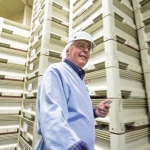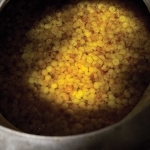Oregon’s distinction of having two of the nation’s largest maraschino cherry producers is no coincidence. An Oregon State University food scientist developed a brining method in the late 1920s that led to modern cherry processing.
OSU’s Ernest Wiegand’s discovery of adding calcium salts to the preserving brine, which reduced cracking and resulted in firmer fruit, is credited with helping Oregon’s cherry industry find a use for surplus fruit and turn fresh cherries into a host of value-added products and ingredients.
Portland-based Gray & Company and Oregon Cherry Growers are said to produce about 65 percent of all maraschino cherries in the United States. Last year, Oregon Cherry Growers processed more than 27 million pounds of cherries.
About half of the cherries went into maraschino-type cherries and 30 percent were made into ingredient products.
Though today’s brining solution used at Oregon Cherry Growers is proprietary, the primary chemical is sulfur dioxide.
During cherry season, fresh cherries are brined in bins until it is their turn to be made into an ingredient for ice cream, a maraschino cherry, or frozen or dried fruit for snacking or baking.
“The cherry brine is a critical step in the process and allows preserving for later processing,” said Marty Hutchinson, plant manager of Oregon Cherry Grower’s Riverside facility in The Dalles.
Hutchinson gave Good Fruit Grower a tour of the Riverside plant, which turns cherries into ingredients for ice cream and other foods and also dries fruit. Here’s a synopsis of the steps involved with brining, infusing, and drying:
1Bins of cherries already pitted, halved, and sorted by size arrive from the cooperative’s downtown facility where they have been stored in brine solution since the previous harvest. The brine keeps fruit shelf stable. Quality evaluations are conducted on each lot before further processing.
2The brine causes cherries to lose their red color, resulting in fruit that are pale and mottled. Brined cherries also have high levels of sulfites, up to 5,000 parts per million.
Because most of the cooperative’s customers want zero sulfite in the fruit, oxidation is used to reduce sulfites to non-detectable levels, a step that involves lots of water and heat and takes about 12 hours.
Laboratory samples are taken to ensure that sulfur dioxide levels are negligible before moving to the next step. Fruit pH is also adjusted to maintain acidity and prevent pathogens from developing.
3Fruit are then manually sorted to remove any missed pits or “bird beaks” (undeveloped fruit doubles) before being sent to infusing tanks.
4A proprietary infusing method uses osmosis to replace water in the fruit with a sugar syrup and color. Infusion can take up to a month.
Temperatures must be maintained during infusion to avoid fermentation and prevent bacterial growth. Depending on the customer, Fair Trade cane sugar, beet sugar, or corn syrup may be used, and colorings may be natural (vegetable-based) or from chemicals.
5After infusion, cherries are quite sweet, depending on customer specifications, and can be up to 60° Brix. Fresh cherries are typically around 20° Brix. Quality assurance testing is conducted after infusion.
6Fruit are sorted once more in search of any stray pits and run over a metal detector before packing in gallon pails or other containers. A ribbon of stabilizer, which may contain sugars, natural gums, colors, and flavors, is used to help move fruit to the packing line. A certificate of analysis accompanies each lot of fruit. Each lot can be traced throughout processing and back to the orchard.
A similar process is used for dried fruit, except that after the infusion process, moisture is removed and fruit are dried to around 14 to 16 percent moisture. A large industrial dryer, with six heating elements (each with a heating capacity of one million BTUs), is used to dry cherries, blueberries, and other fruits. •








Leave A Comment